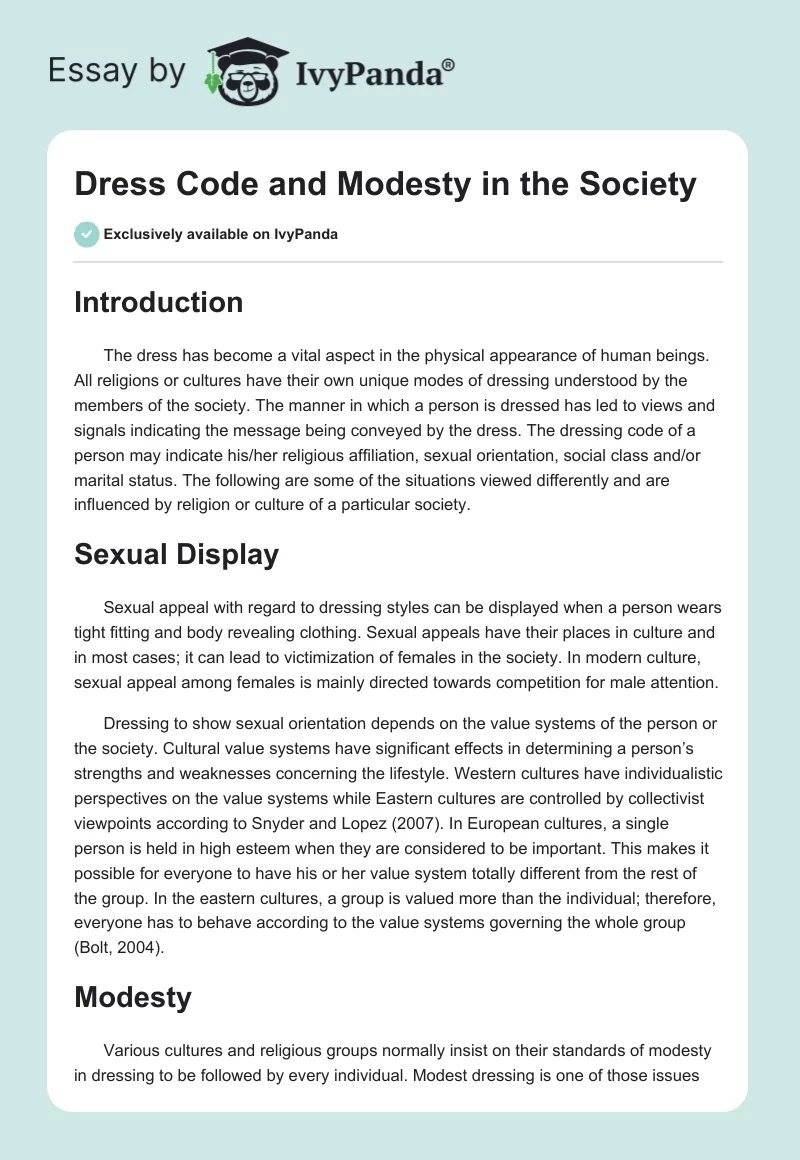Introduction
The dress has become a vital aspect in the physical appearance of human beings. All religions or cultures have their own unique modes of dressing understood by the members of the society. The manner in which a person is dressed has led to views and signals indicating the message being conveyed by the dress. The dressing code of a person may indicate his/her religious affiliation, sexual orientation, social class and/or marital status. The following are some of the situations viewed differently and are influenced by religion or culture of a particular society.
Sexual Display
Sexual appeal with regard to dressing styles can be displayed when a person wears tight fitting and body revealing clothing. Sexual appeals have their places in culture and in most cases; it can lead to victimization of females in the society. In modern culture, sexual appeal among females is mainly directed towards competition for male attention.
Dressing to show sexual orientation depends on the value systems of the person or the society. Cultural value systems have significant effects in determining a person’s strengths and weaknesses concerning the lifestyle. Western cultures have individualistic perspectives on the value systems while Eastern cultures are controlled by collectivist viewpoints according to Snyder and Lopez (2007). In European cultures, a single person is held in high esteem when they are considered to be important. This makes it possible for everyone to have his or her value system totally different from the rest of the group. In the eastern cultures, a group is valued more than the individual; therefore, everyone has to behave according to the value systems governing the whole group (Bolt, 2004).
Modesty
Various cultures and religious groups normally insist on their standards of modesty in dressing to be followed by every individual. Modest dressing is one of those issues considered as very important in the Islamic culture. One modesty rule held by Muslims is that, women are required to wear the hijab, covering all parts of the body except the hands and the face as a assign of modesty. The wearing of the hijab is part of their value system which seems to govern the whole group; no woman is expected to violate the value systems of the Muslim culture.
Christians on the other hand are expected to dress modestly. Christian guidelines on modest dressing indicate that women should cover their upper arms and shoulders. Women clothing, for instance, the skirt should cover up to the knee and the neckline should not reveal anything. Christian modesty rule on dressing also applies to men though they are not always strict as it is with the case of women’s dressing styles.
Dressing styles works best according to different cultures and their value systems. It cannot be said that the western culture is the standard and the best dressing style – better than the eastern cultures. Therefore we must use culture as a lens for evaluating whether dressing style or any other characteristic can be considered a strength or weakness within a particular culture (Snyder and Lopez, 2007).
Dressing styles can declare a person to be a member of certain religion or culture. Clothes may also signify dissent from cultural beliefs as well as personal independence. Muslims may show their religious affiliation by wearing turbans and other religious dresses. In modern cultures, dressing controls and conveys a special message to the society. Extensive change in dressing styles require time, resources (money) and effort to effect. It may take generations to change the dressing style of a particular culture. When dressing style changes, the message conveyed by the cloths also changes.
Conclusion
In summary, every person has amoral duty to obey morality rules concerning body modesty. Universally accepted modesty standards do not allow non-essential exposure of the body. Some of the body parts that should not be uncovered to ensure good modesty standards in the society include; bare skin, hair and undergarments especially those of the private/ intimate body parts. Dress code and modesty in the society should conform to the moral rules regardless of a person’s religion or culture.
References
- Bolt, M. (2004). Pursuing Human Strengths: A Positive Psychology Guide. New York: Worth Publishing. Pp 50-76.
- Lopez, S. J. and Snyder, C. R. (2007). Positive Psychology: the Scientific and Practical Explorations of Human Strengths. Los Angeles: SAGE. pp 43-46


